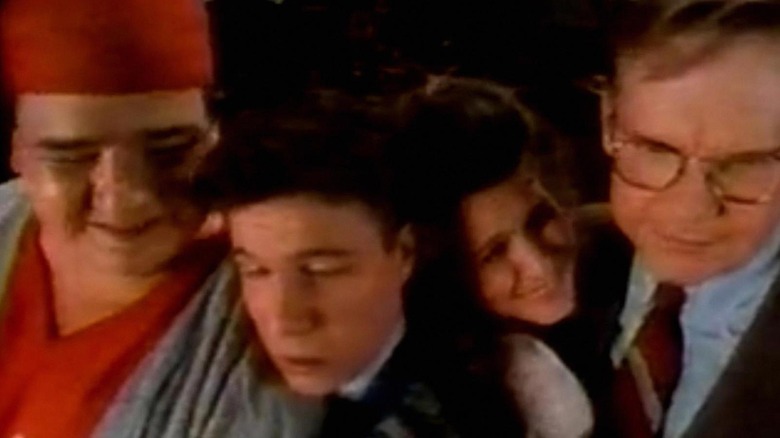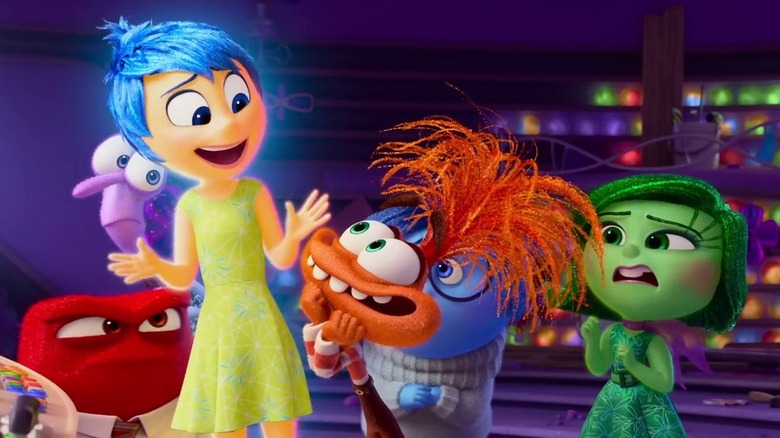A Sitcom With Two Simpsons Stars Was Basically Pixar's Inside Out For Adults
When Pete Docter's animated feature "Inside Out" hit theaters in 2015, many members of Generation X cried foul. The premise of "Inside Out," recall, was that audiences could see anthropomorphic versions of the protagonist's key emotions, living inside a technological "control center," which served as a metaphor for her brain. The protagonist was an 11-year-old girl named Riley (Kaitlyn Dias), and her core emotions were Joy (Amy Poehler), Sadness (Phyllis Smith), Disgust (Mindy Kaling), Fear (Bill Hader), and Anger (Lewis Black). In 2024's "Inside Out 2," Riley began to enter puberty in earnest, and her core emotions were joined by Anxiety (Maya Hawke), Envy (Ayo Edibiri), Embarrassment (Paul Walter Hauser), and Ennui (Adèle Exarchopoulos).
At the time, many critics of a certain age noted that the "Inside Out" premise seemed remarkably similar to a semi-popular Fox sitcom called "Herman's Head" that ran for 72 episodes from 1991 to 1994. "Herman's Head" was about an average yuppie named Herman Brooks (William Ragsdale of "Fright Night" fame), who worked as a fact-checker at a popular magazine. During his efforts to get ahead at work and to copulate with passing women, the action would occasionally cut to a metaphorical attic-like headspace where Herman's four core emotions lived. Unlike "Inside Out," Herman's emotions had names. There was Genius (Peter Mackenzie), who served as Herman's logic and intellect. There was Angel (Molly Hagan), who served as Herman's sensitivity. There was Animal (Ken Hudson Campbell), who was representative of Herman's lust and baser passions. And there was Wimp (Rick Lawless), the personification of Herman's anxiety.
Out in the real world, Herman had regular co-workers he regularly interacted with, and "The Simpsons" fans will certainly recognize two of them. Yeardley Smith, better known for playing the voice of Lisa Simpson, played Louise, Herman's office's secretary, while Hank Azaria, who plays multiple main characters on "The Simpsons," played Jay, Herman's best friend.
Yes, this show was something of a hit.
Inside Out seemingly borrowed its premise from Herman's Head
Herman was always depicted as an average, sexually open city-dwelling man whose sole goal was to bed as many women as possible. The Animal character was certainly one of the show's most active. That said, Herman was also young and kind of naive, and seemed harmless and approachable, for the most part. William Ragsdale infused the character with a puppy-dog-like quality. As the series went on, however, Herman also became more of a schemer, trying to get ahead at his work. The series was reasonably popular, and many members of Gen-X likely saw an episode or two without even trying.
Throw in a few twists, and Herman's head was occasionally occupied by other visiting emotions. Jealousy appeared in one episode and was appealingly played by comedian/director Bobcat Goldthwait. Jealousy was only present when Herman found himself in competition for a job with his sister. The episode concluded with the other four emotions destroying Jealousy with a hand grenade. In another episode, Herman instigated an affair with a married woman while simultaneously dealing with the sadness of watching a beloved uncle on his deathbed. In that moment, Herman's head was visited by God (Leslie Nielsen), who could also have been a personification of Herman's spirituality and conscience. Because Genius is the logical one, he points out that God looks like Leslie Nielsen. It seems that's how Herman pictured the Almighty.
Herman's headspace was, as mentioned, an attic, albeit a very cluttered one. There was no "control panel" like in "Inside Out," and the psyche-bound characters would merely interject the sitcom's main plot to provide color commentary. Like in "Inside Out," Herman's memories were stored via a filing system. In "Inside Out," memories were baseball-sized glowing spheres that were stored on tall shelves. In "Herman's Head," they were kept on paper in a literal filing cabinet.
Inside Out 2 seemingly borrowed other ideas from Herman's Head
A revisited conceit on "Herman's Head" was that the psyche characters would watch in-brain movies as a way of expressing Herman's imagination. Sometimes Herman's imagination would be wholly inappropriate (Animal liked to pop on porno movies), but other times, his imagination would play like a horror flick, with Herman's life falling apart in front of him. This made sense, as anxiety was one of Herman's core emotions.
This was also true of "Inside Out 2," wherein Anxiety played a central role. The "Inside Out" movies also use cinema screens to represent the imagination, and Anxiety captures the power of Riley's mind to envision all the possible negative outcomes of each tiny social interaction. It seems pretty clear that the writers of the "Inside Out" movies were deeply familiar with "Herman's Head." Or the writers of both the Fox sitcom and the Pixar movie found themselves thinking along similar lines.
"Herman's Head" was well-known to the public, and it was popular enough to be lampooned on hit sketch comedy shows of the day, including the undersung and ultra-violent 1992 show "The Edge." In the spoof version of "Herman's Head," a psychopathic disorder (Paul Feig) invades Herman's head and murders the other emotions. In the real world, Herman (comedically) becomes a mass murderer.
The show even became popular enough to become the butt of jokes on "The Simpsons." Hank Azaria plays the smug Comic Book Guy on "The Simpsons," and that character once circulated a petition to bring "Herman's Head" back to the airwaves. In the ultimate meta joke, there was even a scene in the episode "Marge vs. Singles, Seniors, Childless Couples and Teens, and Gays" where Lisa herself was revealed to have anthropomorphic emotions, just like in "Herman's Head." Popular culture is self-reflexive.
"Herman's Head" eventually dropped in the ratings and was canceled in 1994. "Inside Out," however, is a fine legacy to live on with.


